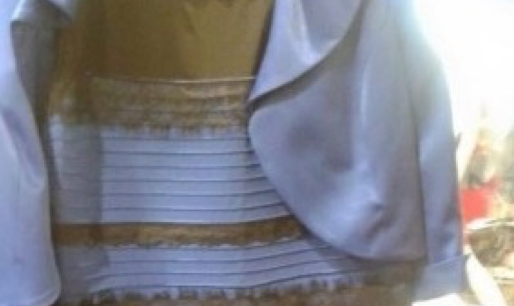If you haven’t been living under a rock, you may have seen this recent meme in late February that got the internet buzzing with debate. A badly lit photo of a dress spread like wildfire with some people seeing it as white and gold, while others as black and blue. If you haven’t seen it, here is an article explaining the craze and the science behind it. My initial reaction, like many others, was disbelief that so many people could be concerned with something so trivial when we have so many more important problems to discuss. However, I’ve now found a silver lining in this dress that I’d like to share.
One of the typical aspects of a dispute is that disputants often have very different perspectives of the situation: «I am right and the other side is clearly wrong», «I am the victim and they are the aggressors», «I’m trying to be fair here but they’re being totally unreasonable» and so on. The funny thing is that both sides often have the same perspective, except with the roles of ‘good’ and ‘bad’ reversed.
A big challenge for a mediator is to find a way to help disputants shift their entrenched (1st person) perspectives, to see the situation from the perspective of the other side (2nd person) and also to look at it more objectively from the (3rd person) perspective of an independent, third party, a judge, for example. What makes this difficult, as demonstrated by the dress meme, is that human beings are wired to perceive reality in quite a subjective way, which often involves a biased perspective.
I’m sure that you have experienced cognitive biases throughout your life, whether you realise it or not. How many times, running late, have you thought that the Universe is out to get you by making you get stuck in traffic, by suddenly putting lots of slow-walking people right in front of you or by making every traffic light red? Did you notice these exact same things when you were not running late? How many times have you thought of someone only for them to then suddenly call or email you? Did you think it was special when the same person called or emailed you without you thinking of them beforehand? There are many more examples of how we shape our perception of the world. I invite you to at least google the topic and have a look at the extensive list of cognitive biases that illustrates just how complex our perception of reality can be and how subjective this can make what we confidently think of as an objective reality. I think this is a very important topic for mediators that is underrated and could be promoted more by those mediators amongst us who come from psychology backgrounds or have an interest in how our minds work.
Joel Lee has a very good article on this blog that examines the issue of cognitive biases and subjective realities. He explains why subjectives realities can differ and presents three simple meta-models for gently challenging a disputant’s subjective reality in favour of a more objective one (or at least a mediator’s subjective reality!). I invite you to read his post, to consider and (hopefully) to share how you help disputants shift their perspectives. For those who prefer videos, I really like Edward Nelson’s pictorial explanation of one way to look at reframing, which you can see here.
The dress meme is a simple and effective example of how people can perceive the world around them in very different ways. In this case I would call it ‘optical bias’ but it is a powerful introduction to the world of cognitive bias. It should illustrate how powerful our subjective perspective can be: «What do you mean it’s blue and black / white and gold?! It’s clearly white and gold / blue and black!!». Let’s use this meme for something constructive in our mediations.
In closing, I would like to extend the theme a bit further. So far I’ve focused on the perspective of two disputants in a mediated dispute. The same entrenched perspectives and cognitive biases apply to our societies in general, to how we perceive conflicts around the world and to how we react to other cultures. What seems common sense, obvious or logical to us might be perceived completely differently by someone else. We often judge people’s behaviours and beliefs from our point of view, not theirs.
I believe that a good way to challenge your own perception is to put yourself in other people’s shoes as much as possible, to experience their reality. I’m very lucky to have the opportunity to travel a lot these days and I highly recommend it. Shifting perspectives intellectually is one thing but experiencing another reality somatically is much more emphatic. As mediators we have the potential to go beyond our mediations and to help people challenge their entrenched perspectives, but not to convince them that there’s a correct or better one, that would be hypocritical. We can at least show people that there’s more than one way to look at reality and, hopefully, that one day we won’t need to fight over the colour of a dress.
________________________
To make sure you do not miss out on regular updates from the Kluwer Mediation Blog, please subscribe here.



